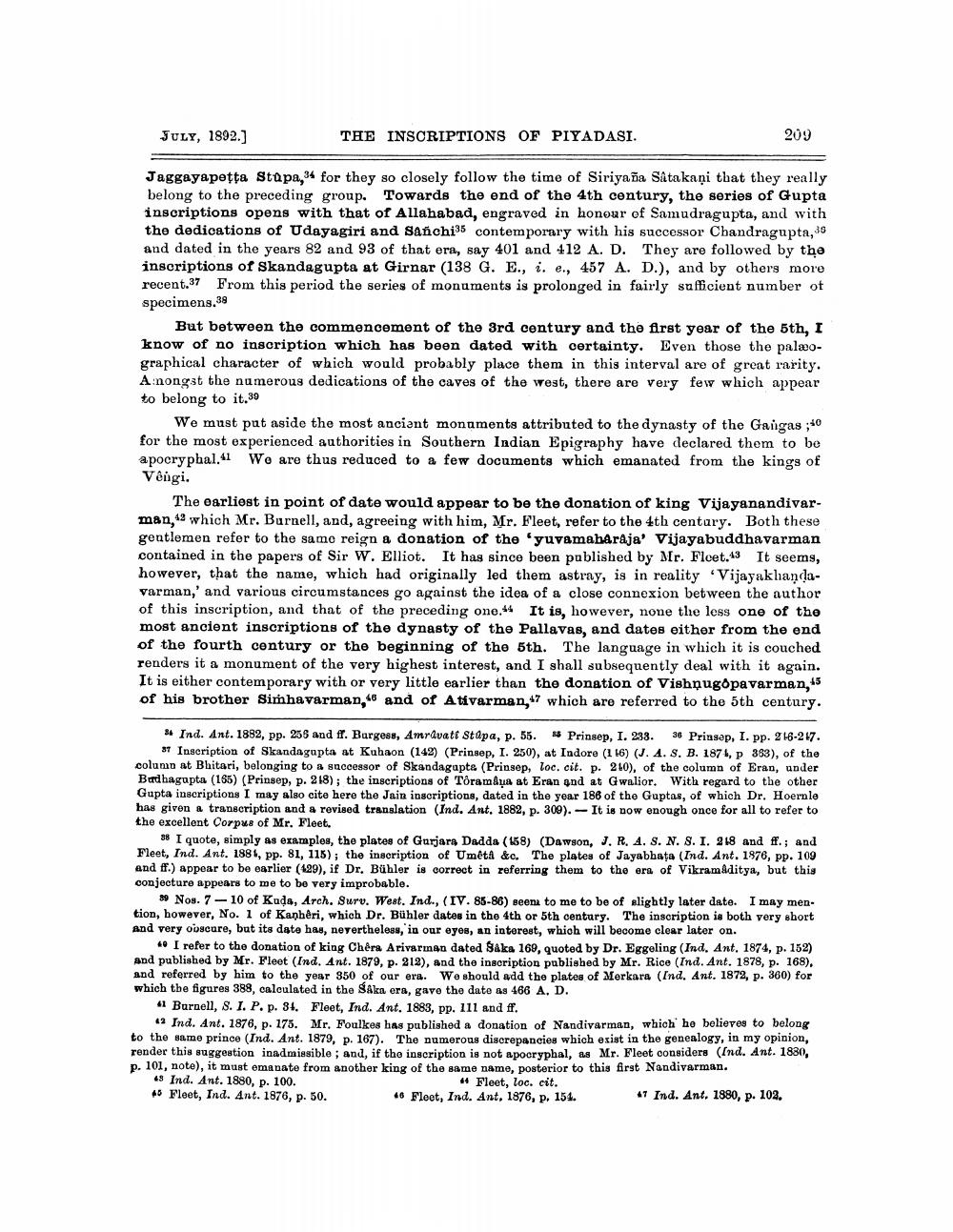________________
JULY, 1892.)
THE INSCRIPTIONS OF PIYADASI.
209
Jaggayapetta Stapa, for they so closely follow the time of Siriyaña Satakaại that they really belong to the preceding group. Towards the end of the 4th century, the series of Gupta inscriptions opens with that of Allahabad, engraved in honour of Samudragupta, and with the dedications of Udayagiri and Sanchi35 contemporary with his successor Chandragupta, JS and dated in the years 82 and 93 of that era, say 401 and 412 A. D. They are followed by the inscriptions of Skandagupta at Girnar (138 G. E., i. e., 457 A. D.), and by others more recent.37 From this period the series of monuments is prolonged in fairly sufficient number of specimens.39
But between the commencement of the 3rd century and the first year of the 5th, I know of no inscription which has been dated with certainty. Even those the palæographical character of which would probably place them in this interval are of great rarity. A:nongst the numerous dedications of the caves of the west, there are very few which appear to belong to it.39
We must put aside the most anciant monaments attributed to the dynasty of the Gangas 10 for the most experienced authorities in Southern Indian Epigraphy have declared them to be apocryphal.41 We are thus reduced to a few documents which emanated from the kings of
Vêigi.
The earliest in point of date would appear to be the donation of king Vijayanandivarman, which Mr. Burnell, and, agreeing with him, Mr. Fleet, refer to the 4th centary. Both these gentlemen refer to the same reign a donation of the 'yuvamaharaja' Vijayabuddhavarman contained in the papers of Sir W. Elliot. It has since been published by Mr. Fleet.43 It seems, however, that the name, which had originally led them astray, is in reality Vijayaklandavarman,' and various circumstances go against the idea of a close connexion between the author of this inscription, and that of the preceding one. It is, however, none the less one of the most ancient inscriptions of the dynasty of the Pallavas, and dates either from the end of the fourth century or the beginning of the 5th. The language in which it is couched renders it a monument of the very highest interest, and I shall subsequently deal with it again. It is either contemporary with or very little earlier than the donation of Vishnugopavarman, 45 of his brother Simhavarman, and of Ativarman,*7 which are referred to the 5th century.
* Ind. Ant. 1882, pp. 255 and fr. Bargess, Amravati Stapa, p. 55. Prinsep, I. 233. 36 Prinsap, I. pp. 266-217.
37 Inscription of Skandagapta at Kahaon (142) (Prinsep, I. 250), at Indoro (116) (J. 4. S. B. 1874, P 383), of the column at Bhitari, belonging to a successor of Skandagapte (Prinsep, loc. cit. p. 210), of the column of Eran, under Budhagupta (155) (Prinsep, p. 218); the inscriptions of Tôramaya at Eran and at Gwalior. With regard to the other Gapta inscriptions I may also cito here the Jain inscriptions, dated in the year 188 of the Guptas, of which Dr. Hoernle has given a transcription and a revised translation (Ind. Ant. 1882, p. 309). - It is now enough once for all to refer to the excellent Corpus of Mr. Fleet.
38 I quote, simply as examples, the plates of Gurjara Dadda (158) (Dawson, J. R. A. S. N. 8. I. 218 and ff.; and Fleet, Ind. Ant. 1881, pp. 81, 115); the inscription of Umêta &c. The plates of Jayabbata (Ind. Ant. 1876, pp. 109 and ff.) appear to be earlier (429), if Dr. Bühler is correct in referring them to the era of Vikramaditya, but this conjecture appears to me to be very improbablo.
89 Nos. 7-10 of Kuda, Arch. Suru. West. Ind., (IV. 85-86) seena to me to be of slightly later date. I may men. tion, however, No. 1 of Kanhêri, which Dr. Bühler dates in the 4th or 5th century. The inscription is both very short and very obscure, but its date has, nevertheless, in our eyes, an interest, which will become clear later on.
* I refer to the donation of king Chêra Arivarnan dated Baka 169, quoted by Dr. Eggeling (Ind. Ant. 1874, p. 152) and published by Mr. Fleet (Ind. Ant. 1879, p. 212), and the inscription published by Mr. Rice (Ind. Ant. 1878, p. 168), and referred by him to the year 350 of our era. We should add the plates of Merkara (Ind. Ant. 1872, p. 360) for which the figures 388, caloulated in the SAka Ora, gave the date as 466 A, D.
41 Burnell, 8. I. P. p. 34. Fleet, Ind. Ant. 1883, pp. 111 and ff.
12 Ind. Ant. 1876, p. 175. Mr. Foulkes has published a donation of Nandivarman, which ho believes to belong to the same prince (Ind. Ant. 1879, p. 167). The numerous discrepancies which exist in the genealogy, in my opinion, render this suggestion inadmissible; and, if the inscription is not apocryphal, a Mr. Fleet considera (Ind. Ant. 1880, p. 101, note), it must emanate from another king of the same name, posterior to this first Nandivarman. 48 Ind. Ant. 1880, p. 100.
# Fleet, loc. cit. 45 Fleet, Ind. Ant. 1876, p. 50.
46 Fleet, Ind. Ant, 1876, p. 154. 47 Ind. Ant. 1880, p. 102.




